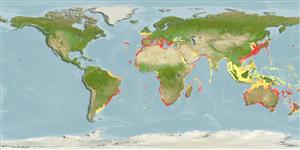Common names from other countries
Environment: milieu / climate zone / depth range / distribution range
Ecologie
; diepteverspreiding 5 - 750 m (Ref. 105665). Tropical; 51°N - 46°S, 68°W - 180°E
Indo-West Pacific, Atlantic Ocean and the Mediterranean.
Length at first maturity / Size / Gewicht / Leeftijd
Maturity: Lm ? range ? - ? cm
Minimum depth from Ref. 82060. Bathyal. Inhabits continental shelf and slope (Ref. 2782). It is eurybathic, on coastal detritic bottoms to bathyal muds (Ref. 105665). Uses shells of Bittium latreilli (Ref. 105639). Opportunistic scavenger and predator. Feeds on live crabs, dead shells and fishes (Ref. 106108). Other isotope data (δ15N=9.66±0.25, Ref. 106518).
Life cycle and mating behavior
Geslachtsrijpheid | Voortplanting | Kuitschieten | Eieren | Fecundity | Larven
Members of the order Decapoda are mostly gonochoric. Mating behavior: Precopulatory courtship ritual is common (through olfactory and tactile cues); usually indirect sperm transfer.
Markham, J.C. 2003. (Ref. 2782)
Status op de Rode Lijst van het IUCN (Ref. 130435)
Status bij CITES (Ref. 108899)
Not Evaluated
Not Evaluated
Gevaarlijk voor mensen
Harmless
Gebruik door de mens
| FishSource |
Tools
Meer informatie
Leeftijd/Grootte
Groei
Lengte-gewicht parameters
Lengte-lengte parameters
Morfologie
Larven
Abundantie
Internet-bronnen
Estimates based on models
Preferred temperature
(Ref.
115969): 9.3 - 20.6, mean 14.8 (based on 532 cells).
